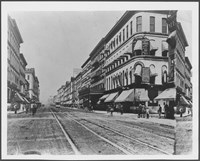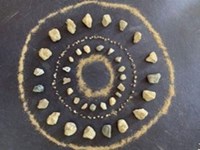- Lesson Plan (10)
- Field Trips (5)
- Student Activities (4)
- Distance Learning (1)
- Science (16)
- Social Studies (5)
Showing 20 results for sediment suspension ...
Sediment Sorting
Sediment Deposition at Sea
- Type: Student Activities
- Grade Levels: Middle School: Sixth Grade through Eighth Grade

Through this activity, students will learn about depositional and erosional effects as rivers meet the sea. As a river meets the sea, the sediment it carries is deposited in a fan-like formation called a delta. As longshore drift picks up and transports the sediment, it can be carried and deposited down current to form shoreline sediment features such as sand bars, spits, and barrier islands.
Sediment Effects of Elwha Dams
Freeing the Elwha (Sediment Deposition and River Structures)
Freeing the Elwha (River Flows and Sediment Movement)
- Type: Lesson Plan
- Grade Levels: Middle School: Sixth Grade through Eighth Grade
Segregation Laws in the 1800s: Williams v. Bellefontaine
- Type: Field Trips
- Grade Levels: Upper Elementary: Third Grade through Fifth Grade

In 1867, Neptune and Caroline Williams sued the Bellefontaine Railway Company over its discriminatory policies regarding African Americans. In a dispute with the streetcar operator, Mrs. Williams was hurt. The Williamses sued at the St. Louis Courthouse and won their case, but with a twist. Will students reach the same verdict?
Beaches in Motion - Coastal Vulnerability
- Type: Field Trips
- Grade Levels: Upper Elementary: Third Grade through Fifth Grade
This Earth Science lesson includes classroom materials, field trip activities and a post assessment activity. The classroom lessons include Powerpoints, readings and activities to increase understanding of coastal processes. The beach activities offer place –based learning to observe and measure conditions to evaluate the vulnerability of a beach to erosion. The post assessment activity requires students to use a model to demonstrate a beaches response to different climate
Trial for the Right to Vote: Virginia Minor v. Happersett
- Type: Field Trips
- Grade Levels: Upper Elementary: Third Grade through Fifth Grade

In a room on the second floor of the St. Louis Courthouse in 1873, Virginia Louisa Minor sued a city registrar for denying her the right the register to vote. What was her argument? In this mock trial, students will reenact the 1873 trial, listen to both sides, and reach their own verdict in the case.
Tort Liability: Franke v. City of St. Louis
- Type: Field Trips
- Grade Levels: Upper Elementary: Third Grade through Fifth Grade

Frederick Franke was injured in St. Louis when part of a building fell on his head as he was walking. Tragically, he died as a result of his injuries. His mother, Julia Franke, sued the owner of the building and the City of St. Louis for damages. This case was heard in 1888 in the St. Louis Courthouse (the Old Courthouse). Students will reenact the case and hear from all sides.
Freedom Suit: Dred Scott v. Irene Emerson
- Type: Field Trips
- Grade Levels: Upper Elementary: Third Grade through Fifth Grade

1846, an enslaved couple named Dred and Harriet Scott sued for their freedom at the St. Louis Courthouse, a historic courthouse managed by the National Park Service at Gateway Arch National Park and referred to as the "Old Courthouse." In this mock trial, students learn about the second trial the Scotts undertook at the courthouse in 1850. During this case, the court declared Dred Scott to be a free man. How will students interpret the case?
Erosion and Preservation of the Water Table
Virtual: Grades 4-5, Sedimentary Sleuths
Shoebox Geologist
- Type: Student Activities
- Grade Levels: Middle School: Sixth Grade through Eighth Grade
Watershed Lessons
Making a Fossil Game
- Type: Lesson Plan
- Grade Levels: Lower Elementary: Pre-Kindergarten through Second Grade
Organisms in and Around Water
- Type: Lesson Plan
- Grade Levels: Middle School: Sixth Grade through Eighth Grade

• Students will take a look at different ways water makes its way to a pond/lake. • Students will also be thinking about how that water carries contaminants and sediment and what impact that has on ponds/lakes. • Students will make a food chain and/or a food web to share what biotic factors play a role in watersheds.
Concentric Sedimentary Circles
- Type: Student Activities
- Grade Levels: Upper Elementary: Third Grade through Fifth Grade
Biological Indicators
- Type: Lesson Plan
- Grade Levels: High School: Ninth Grade through Twelfth Grade

Macroinvertebrates can be found in bodies of water buried in sediments and detritus or attached to rocks or plants. They are visible without magnification and can be used by scientists to measure water quality. In this lesson, introduce your students to these organisms and to the use of a dichotomous key. Students will hone basic identification skills to increase the reliability of data they may collect during a visit to Cuyahoga Valley National Park.












